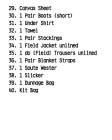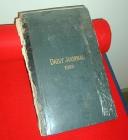14
13. 1 do [Pair] Mitts wool.14. 1 do [Pair]do [Mitts] elk
15. 1 do [Pair] Moccasins
16. 1 Field Jacket lined
17. 1 do [Field] Trousers lined
18. 1 Muffler
19. 1 Water Proof sheet
20. 1 Clothes Brush
21. 1 Hair do [Brush]
22. 1 Button do [Brush]
23. 1 Boot do [Brush]
24. 1 Holdall complete
{knife, fork, spoon, raiser, comb, shaving brush, button brass, sponge}
25. 1 Pair Goggles
26. Haversack
27. 1 Burnisher
28. 1 Pair Boots (Long)
16
29. Canvas Sheet30. 1 Pair Boots (Short)
31. 1 Under Shirt
32. 1 Towel
33. 1 Pair Stockings
34. 1 Field Jacket unlined
35. 1 do [Field] Trousers unlined
36. 1 Pair Blanket Straps
37. 1 Soute Wester
38. 1 Slicker
39. 1 Dunnage Bag
40. Kit Bag
18
Upon enlistment in the 1880s, Constable John G. Donkin recorded the scale of rations per man per diem as such:1 ½ lbs beef or 1 lb bacon
1 ½ lbs bread or 1 ¼ lb flour, or 1 ¼ lb biscuit
½ oz tea
½ oz Coffee
½ oz salt
3 oz sugar
1 oz rice
1/36 oz pepper
1 lb potatoes, or 2 ozs dried apples; or 2 oz beans
20
Armed for the Cause22
The Winchester Model 1876 Carbine was introduced into the North-West Mounted Police in 1878, after the establishment of the force headquarters and stayed until 1914.The typical carbine weighed 8 lbs 4 oz, a barrel length of 22 inches, tangent leaf rear sight and barley corn enpost fore sight, used a .45/75 calibre bullet and had the capacity of holding 8 rounds in the magazine.
24
The manner in which it was carried was directly reflective of the duty of the officer and were based on factors, with the first being obvious - the horse accepted the weight of the carbine; the next, uniformity in drill appearance; and lastly, allowing free movement of the police officer to control and guide his horse."The Bucket to be used in long marches, where there is no probability of the men coming into action, and also on ordinary mounted (drill) parades. The Sling to be used in cases where a probability exists of men coming into action at any moment; and again by men out in small numbers on detachment or patrolling duty."




